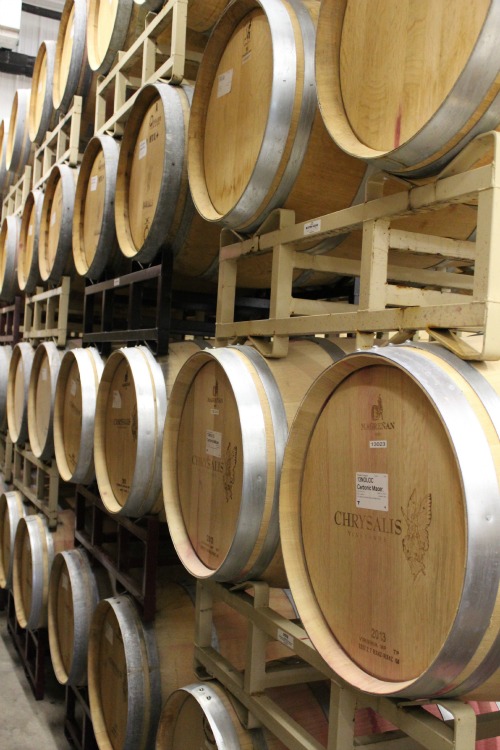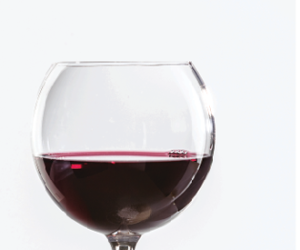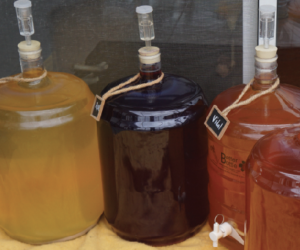 Oak barrels have long been used primarily for aging red wines but also to shape the style of certain white varietals, such as Chardonnay, into fuller-bodied wines.
Oak barrels have long been used primarily for aging red wines but also to shape the style of certain white varietals, such as Chardonnay, into fuller-bodied wines.
Oak wood imparts what is generally referred to as toasted-oak aromas and flavors, but more specifically, these include a varied set of volatile compounds, from aldehydes to oak lactones, and non-volatile compounds, mostly hydrolyzable tannins such as ellagitannins.
Oak barrels also allow for the graceful maturation of wine through interactions with infinitesimally small amounts of oxygen in what is called micro-oxygenation or micro-oxidation effects. These occur via various physical and chemical phenomena, or barrel dynamics, all interacting in complex fashion and which alter the interplay between wine and wood.
Here, we examine barrel kinetics and dynamics and how these interactions modify organoleptic qualities of wine. In chemistry, one would refer to kinetics when describing the reaction rates or ‘pace’ at which a reaction takes place. Dynamics, on the other hand, would refer to the nature of the chemical reactions taking place (e.g. hydrolysis, oxidation, etc.). It is important to distinguish the two because the choice of barrel will have an impact on timing (kinetics) and the chemical constituents (dynamics) imparted to the wine.
It is important to note the terms micro-oxidation and micro-oxygenation are often used interchangeably in barrel aging discussions. Here, micro-oxidation is used (for the purpose of
this article) to refer to the general oxidation phenomenon occurring in but not limited to barreled wines; the use of the term micro-oxygenation is used to describe the small amount of oxygen penetrating barrels — it is also used to refer to the specific practice of injecting oxygen to emulate micro-oxidation effects in barrels.
Barrel kinetics and dynamics
Wood is a porous material and acts as an exchange system between the cellar atmosphere and the wine — this is what is meant when people say that “barrels breathe.” Oak wood also contains many extractable compounds, such as hydrolyzable tannins (mainly ellagitannins), furfurals, phenolic
aldehydes, volatile phenols and lactones, which are transferred into the wine and impart favorable organoleptic properties and react with other wine compounds.
As barrels breathe, there is an outward transfer of ethanol, carbon dioxide (CO2) and water due to evaporation through stave and head segment joints, and through the wood as it absorbs wine and forms a gradient to a depth of approximately 7⁄32 inch (5.5 mm). Newer wood absorbs more wine and at a faster rate. The rate of evaporation is a function of environmental factors, namely, cellar humidity, temperature and ventilation, as well as barrel age. Evaporation and absorption cause wine loss thereby creating an oxygen-buffering headspace, or ullage, which hastens oxygen dissolution into wine and oxidative effects. Barrels must be regularly filled, or topped up, to replenish evaporated wine and avoid over-oxidation, which could otherwise oxidize and spoil the wine.
Barrel thermokinetics are also an important factor where there is little temperature control or where heat loss must be managed closely. Wood is a poor thermo-conductor and therefore there is considerably less heat lost to the atmosphere. Fermentation in barrels may be better suited in a cold environment to minimize heat loss compared to the much greater loss with stainless steel tanks. A barrel is estimated to be 5,000 to 10,000 times thermally more inert compared to a stainless steel tank of similar physical characteristics.
There is an infinitesimally small amount of oxygen ingress, or micro-oxygenation, through wood staves and the tight but porous joints between stave and head segments, and possibly more significant amounts around the bung. One study by world-renown researcher Nicolas Vivas showed that 21% of oxygen ingress was from the bung hole, 63% from between staves, and 16% percent through the wood. Oxygen ingress via the bung hole was lowest to highest for a wooden bung with the bung hole in the top position, followed by a wooden bung with the bung hole in the side position, and then by a silicone bung with the bung hole in the top position.
Any oxygen entering the barrel slowly dissolves in the wine to increase the level of dissolved oxygen (DO). Vivas measured the amount of oxygen dissolved into wine during barrel aging to be in the order of 20–30 mg/L/year for new, tight-grained oak barrels compared to 10 mg/L/year for a barrel that was previously used for aging five wines.
Dissolved oxygen then initiates a series of oxidative reactions or acts as a catalyst in various types of reactions, the most important being those between and among tannins (T) and anthocyanins (A), with or without acetaldehyde mediation. Acetaldehyde from, for example, yeast fermentation and ethanol oxidation, can mediate condensation (polymerization) reactions by acting as a bridge between tannins and anthocyanins.
Tannins and anthocyanins condense to form increasingly large tannin–anthocyanin complexes (i.e., T–A–T, T–A, A–A–A and T–T–T) that will precipitate during maturation and cause a “softening” of tannins from a shift from bitter to astringent tannins, and intensification and stabilization of color. The precipitate will encrust the barrel surface by filling the pores and impede compound transfers between wood and wine.
In the presence of iron and copper acting as catalysts, oxygen can oxidize polyphenols into their brown-colored quinones and generate peroxides, namely, hydrogen peroxide (H2O2). Quinones are the compounds responsible for what is known as phenolic browning in wines. Phenolic browning in barreled wine occurs through chemical oxidation, a reaction similar to enzymatic browning that occurs while processing juice due to naturally occurring, copper-containing polyphenoloxidase (PPO) oxidative enzymes.
Polyphenols also include those within the wood structure and ellagitannins, which can then become transferred into the wine in their oxidized forms while exacerbating peroxide production. If not protected with sulfite, H2O2 can oxidize ethanol into acetaldehyde, which can then bridge tannins and anthocyanins into pigmented polymers. Similarly, quinones can condense with tannins and anthocyanins to form more pigmented polymers that can affect wine color.
As for sulfur dioxide (SO2), there is a drop in free SO2 within the first few days of transferring wine into barrels as molecular SO2 binds with carbonyls (e.g. acetaldehyde, pyruvic acid from fermentation, etc.) and reaches equilibrium. There is a small loss of free SO2 out of the barrel; however, there can be important losses into the headspace and out of the barrel when the bung is opened if barrels are not topped up regularly. Following binding, free SO2 drops are due to oxidation reactions. By keeping the barrel full, the infinitesimally small oxygenation essential to the wine’s development is controlled under the protection of free SO2.
Micro-oxidation — and therefore aging — as well as phenolic extraction occur at a slower rate in larger barrels given the smaller surface-to-volume (S/V) ratio. For example, a 55-L (14-gal) barrel has an S/V ratio 1.5 times that of a Bordeaux-style barrique of 225 L (59 gal). And fine-grained oak releases smaller amounts of phenols than coarser-grained oak. This slow, regular release may continue for several years; the rate of extraction is also affected by the wine’s acidity and alcohol.
Barrel kinetics and dynamics can also be dramatically different in barrel fermentation compared to barrel maturation.
Ellagitannins and bacteria
Ellagitannins from oak barrels are known to be inhibitory towards bacteria, including malolactic bacteria (MLB), although the method of action and level of toxicity are not well understood. Given ellagitannins’ effect on bacteria, new barrels are generally recommended and preferred over used barrels. Malolactic fermentation (MLF) can, however, still complete successfully in red wine with high levels of these compounds. Ellagitannins do seem to lose their inhibitory action on MLB as they complex with other wine compounds.
Barrel alternatives
Barrel alternatives such as oak powder, granules, chips, whole or notched segments, staves and infusion sleeves (what can be collectively called oak adjuncts) are meant for “oaking” wine without the benefit of micro-oxidation phenomena. Micro-oxygenation (MOX) is a true alternative in replicating barrel chemistry.
The most important consideration with oak adjuncts is the rate of transfer of oak compounds given the much higher wood surface area and end-grain (cross-cut) exposed to wine. There are significantly different compounds extracted from end-grain.
Wine penetrates at a very slow rate across the length (parallel axis) of staves in barrels; there is no end-grain exposed in barrel staves. Wine penetrates much more rapidly across the end-grain in barrel alternatives, and so this must be compensated by reducing the amount of wood used. The amount of oak wood required should be determined and administered in g/L (or as a percent of weight to volume where 1% is 10 g/L) as opposed to contact surface area — this emulates barrels more closely and minimizes extraction divergence from expectations. Bench tests are essential in determining the “right” level of oak for your wine and your palate.
A recent study by Crawford et al. (2014) reports that furfurals, those compounds responsible for caramel, bread and toasted almond aromas, are extracted more rapidly from cross-cut ends than from wood on the parallel axis, and that vanillin extraction was only measurable in the cross-cut axis exposed wood during the 12-month exposure in the experiment. And as was to be expected, their study showed that cross-cut grain exposure impacts both rate of extraction and total extractable amount of oak flavor molecules; but more significantly, molecules with limited water solubility and larger size were extracted in higher amounts from cross-cut oak. These results would indicate that compound extraction and rate of extraction are different amongst the various types of barrel alternatives.







